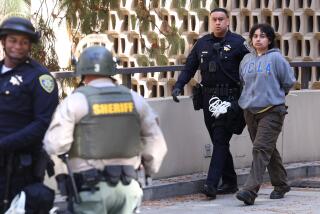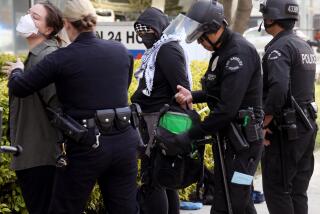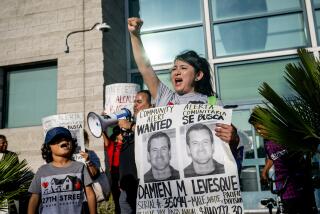The LAPD arrested 462 people in anti-Trump protests. Only three were criminally charged, Times analysis finds
During demonstrations that erupted across the nation after the election of President Trump last year, the Los Angeles Police Department arrested hundreds of protesters — far more than any other law enforcement agency in the country.
Of the 462 people arrested during marches that wound through downtown, Westlake and onto the 101 Freeway between Nov. 7 and Nov. 12, most were held on suspicion of blocking a roadway or failing to disperse after officers declared unlawful assemblies.
But nearly a year later, a Times analysis of arrest records shows, the LAPD has sought formal charges in only 10 cases, and prosecutors have filed charges against just three people. In all, three felony cases were filed with prosecutors, but two were dismissed due to lack of evidence, according to the Los Angeles County district attorney’s office. Of seven misdemeanor cases presented to the city attorney’s office, only two resulted in charges, according to spokesman Rob Wilcox.
The low number of charges has renewed criticism that the LAPD was too aggressive in arresting protesters. Civil liberties advocates said the LAPD tactics used last year could deter people from exercising their 1st Amendment rights.
Other cities saw larger, and far more violent, demonstrations but arrested fewer people. Police in Oakland recorded 60 arrests during protests in the same time frame, even after demonstrators hurled Molotov cocktails at officers. Portland police made roughly 100 arrests during demonstrations that law enforcement officials there described as a riot.
Los Angeles and other major cities are bracing for a new wave of protests near the anniversary of Trump’s election victory. The group Refuse Fascism has called for anti-Trump demonstrations across the country, including an event slated for Saturday afternoon in Pershing Square. Several law enforcement officials, speaking on the condition of anonymity, told The Times that local agencies are gearing up for demonstrations this weekend.
Amid those preparations, the Los Angeles City Council on Wednesday approved a controversial ordinance that would prohibit demonstrators from carrying a wide array of items at protests, which could provide additional grounds for arrests. The ordinance largely bans items that are already illegal to possess or brandish openly — including guns, swords and “martial arts weapons” — and severely limits the kinds of signs that can be carried. The ordinance was driven in part by violence seen during demonstrations in Berkeley and Charlottesville, Va., in recent months and has drawn sharp criticism from the American Civil Liberties Union.
LAPD Cmdr. Vito Palazzolo said there were several reasons for the low number of charges stemming from the 2016 protests. In the case of those arrested for blocking roadways, the LAPD sought charges in municipal traffic court, which no longer handles those types of cases, he said. Department officials said they chose not to refile those cases because the purpose of the arrests was to end protests that were growing unruly, not to seek convictions of demonstrators.
In other cases, officers may have failed to take the time to gather sufficient evidence against demonstrators whom they were trying to process quickly, he said. The LAPD did not want to hold demonstrators unless they had an active warrant or were accused of a more serious crime than unlawful assembly.
“We had the probable cause to make those arrests, but we didn’t want to keep people incarcerated overnight,” Palazzolo said.
LAPD Assistant Chief Michel Moore credited officers for using minimal force and said the lack of charges was not a concern. Officers allowed protesters to march for several hours but moved to stop the demonstrations because of episodes of illegal conduct and the fact that the spontaneous demonstrations were stretching resources thin, Moore said. The LAPD racked up more than $2 million in overtime costs during the protests, officials said.
“We effected arrests as a means of stopping violence, of stopping property damage,” Moore said. “In some cases, of stopping things from going on to infinity.”
But others worry the widespread arrests could have a chilling effect on future marches.
Jim Lafferty, executive director for the National Lawyers Guild in Los Angeles, said he feared the LAPD’s tactics might deter protesters from attending future demonstrations.
Several of the guild’s legal observers said officers last year gave confusing dispersal orders and made arrests without giving protesters a chance to comply, Lafferty said.
“They join a protest, it’s peaceful … and without further ado they’re all arrested after being lulled into believing that’s what they can do,” he said. “I think that’s outrageous behavior on the part of the Police Department.”
Many of the protests last November followed a similar pattern. Demonstrators would marshal at a central location, typically City Hall or Pershing Square, then march through downtown, freezing traffic along Spring Street and outside Staples Center. The protests were largely peaceful, with police intervening only to prevent vandalism or stop demonstrators from entering a freeway.
Nearly a third of the arrests took place on the final night of protests, when Los Angeles police officers detained nearly 150 demonstrators who took part in a winding, hours-long march. The LAPD declared an unlawful assembly in front of City Hall and ordered marchers to leave Spring Street, but then arrested dozens who had sat down to rest in Grand Park. Several tried to leave peacefully but were denied by officers.
“We didn’t know we were doing anything wrong. We just thought they were there to watch us, and we thought they were going to escort us out,” said Gail Reznik, a 59-year-old paralegal from Calabasas who was arrested but not charged.
One protester arrested on the 101 Freeway pleaded guilty to misdemeanor possession of brass knuckles, and another pleaded no contest to vandalism charges, Wilcox said. Five other protesters who were arrested by the LAPD for blocking a thoroughfare were ordered to attend informal hearings, according to Wilcox, but the city attorney’s office declined to charge them.
A 20-year-old woman was charged with felony assault with a deadly weapon after she was involved in a brawl that left a police officer injured outside LAPD headquarters that week. She later pleaded guilty to one count of disturbing the peace, according to court records.
Other large-scale protests this year, including demonstrations at Los Angeles International Airport after the White House issued the first version of an executive order limiting travel from seven mostly Muslim countries, resulted in few, if any, arrests. The department has also made efforts to collaborate with protest organizers to create more manageable conditions, as it did on Inauguration Day, Moore said.
But the LAPD has struggled over the years to strike a balance between public safety and 1st Amendment rights when policing large-scale demonstrations.
In 2014, the LAPD arrested 323 protesters angered by a grand jury’s decision not to charge the officer who shot and killed 18-year-old Michael Brown in Ferguson, Mo. Months later, the city attorney’s office decided to bring charges against 27 people and formally rejected charges in 181 cases.
The department’s overzealous response in 2007 to May Day protests in MacArthur Park, which left 250 people injured and led to lawsuits and policy reforms, also looms large in the minds of some civil liberties advocates.
“I think that the LAPD needs to look at its policies and bring them up to date with the law. There’s a lot of cases out there that say, ‘Look, when you allow people to march without a permit, then you have to allow them to march without a permit,’ ” said Carol Sobel, a civil rights attorney who has successfully sued the LAPD over its handling of protests in the past. “You need to allow spontaneous speech. You need to be really clear about the parameters.”
Follow @JamesQueallyLAT for crime and police news in California.
More to Read
Sign up for Essential California
The most important California stories and recommendations in your inbox every morning.
You may occasionally receive promotional content from the Los Angeles Times.











